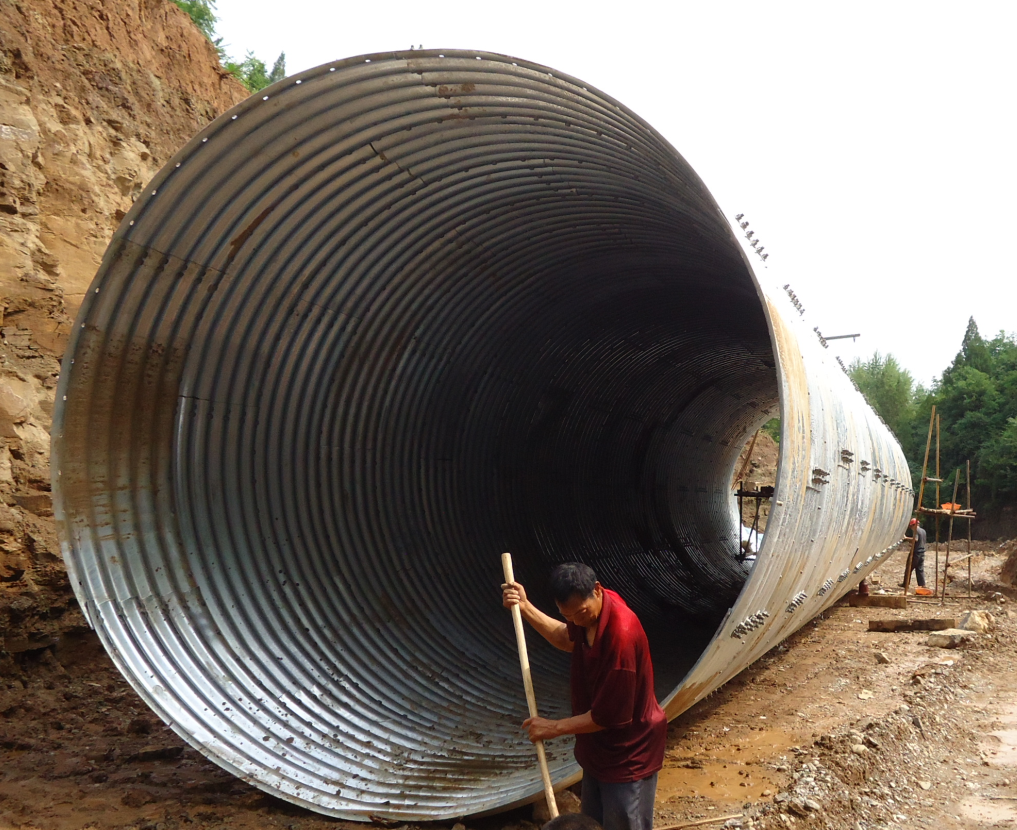Jul. 09, 2020
(1) Assembly and cutting of metal corrugated steel pipe culvert
1. Handling, transportation
Metal corrugated culvert pipe section should be careful when lifting, transporting, unloading and stacking. Rolling, collision with hard objects and knocking are strictly prohibited to avoid deformation of the corrugated steel pipe culvert wall or damage to the galvanized protective layer and Anti-corrosion coating layer.
2. Regarding the construction technology and quality inspection standards of metal corrugated steel pipe culverts, in addition, according to the characteristics of this structure, the following points are proposed:
(1) Assembly requires that the pre-tightening torque of all bolts is 340N·m±70N·m, and the tolerance of the diameter after assembly is ±1% of the standard diameter value.
(2) After the foundation is leveled and tamped, corrugated pipes can be installed at the site, and no dense realizations are allowed between the pipe wall and the foundation.
(3) The backfilling of the earthwork on both sides should be balanced, the thickness of each layer is not more than 500px, compacted and assembled with a small compaction machine.
(4) Each pipe section of the metal corrugated steel pipe culvert must be a whole, and the surface of the weld must not have defects such as pores, cracks, slag inclusions and spatter.
(5) If the water quality of the culvert is highly corrosive, the thickness of the anti-corrosion coating should be increased.
(6) When assembling metal corrugated steel pipe culverts, it is required that the number of plates at any point in the collection is not more than 3, so that the plate joints are staggered as much as possible. When the corrugated board is installed, the joints of the plates must be kept clean to ensure that each corrugated board is tight and the joints are tightly joined. The short pipe culvert can be assembled at a nearby construction site, and then transported to the culvert to be hoisted in place; the long culvert pipe can be assembled in sections first, then lifted to the culvert and then docked.

Metal Corrugated Culvert Pipe
When assembling the metal corrugated steel pipe culvert, the end of the downstream block must be placed under the upstream block to prevent the water in the pipe from seeping into the joint and eroding the foundation soil, resulting in the destruction of the whole pipe culvert. When assembling large-diameter culvert pipes, a movable wooden workbench can be set in the pipes to facilitate the assembly work. When assembling with bolts, the method of sending bolts can be used for assembly, that is, each screw hole is inserted into the bolt first, after the nut is fitted, the nut is tightened slightly, and the nut is not tightened. After all the blocks are assembled, the nut is tightened one by one. The torque of each nut should meet the requirements of relevant specifications. When using a motorized wrench, the wrenching time should last 2S~5S. When gas cutting bellows, it is required that the cut edges are free of oxides and burrs. Where the galvanized protective layer is damaged, an anti-rust agent must be applied to prevent corrosion.
(2) Temporary support
Metal corrugated steel pipe culverts are prone to deformation during the filling process, and the amount of sinking at the top of the tube is usually greater than the deformation when filling the tube side, making the round tube into a flat tube. In order to avoid this unfavorable situation, a row of temporary supports can be set in the pipe before the top of the pipe is filled with soil. The support spacing is 1m. The height of the temporary support can be set according to the diameter of the corrugated pipe by 2% to 5%. The compression amount is reserved under the action of earth pressure. For metal corrugated steel pipe culverts with a diameter greater than 2.0m, it is advisable to install horizontal cross-shaped supports. The temporary supports in the pipes are to be removed after the filled soil no longer sinks.
(3) Construction technology and requirements of filling materials
1. The construction process fill shall be carried out synchronously and symmetrically on both sides of the culvert, and the height difference of the backfill on both sides shall not be greater than 750px. The fill must be stratified by ramming. Within 1750px above the top of the pipe, the fill should be layered and compacted, each layer is 375px thick, and the rest of the fill should be layered and compacted by 15~625px. Degree is not less than 96%.
When the fill of the metal corrugated steel pipe culvert is less than 50cl, rollers larger than 6T shall not be used for rolling and construction machinery shall not be allowed to pass through. When the top fill of the pipe meets the minimum thickness of each pipe diameter, it can be rolled with a vibratory roller, allowing construction machinery to pass through. The compaction of compaction machinery is used within 1250px on both sides of the maximum diameter of the pipe body to avoid the collision of large mechanical equipment such as rollers with the pipe culvert. It is not allowed to use dynamic compaction machinery within 20m on both sides and top of the pipe body.
2. Requirements for filling materials
In the fill within 750px from the metal corrugated steel pipe culvert, there should be no stones or concrete blocks, frozen soil blocks, high plastic clay blocks or other harmful substances with a large side size exceeding 200px, otherwise it will cause the metal corrugated steel pipe culvert Local deformation and corrosion of pipe culvert.
We are Corrugated metal culvert manufacturers, if you are interested in our products, please feel free to contact us.
Other Blog
 Highway Construction
Highway Construction  Mine Projection
Mine Projection  Municipal Engineering
Municipal Engineering  Irrigation Engineering
Irrigation Engineering  Railway Construction Projection
Railway Construction Projection  Other Application
Other Application Do you need a project solution?
With first-class products and services, and make greater contributions